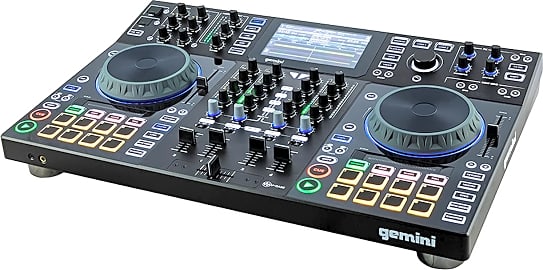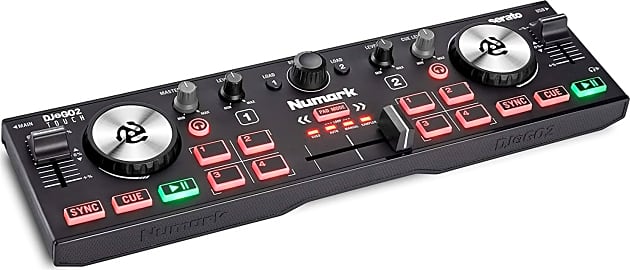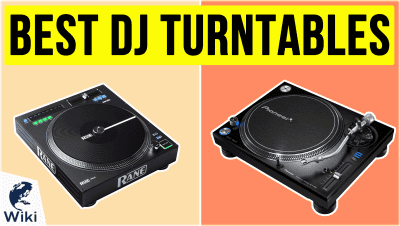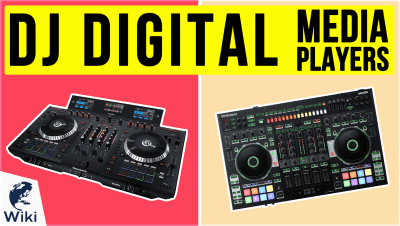The 10 Best DJ Controllers

This wiki has been updated 36 times since it was first published in September of 2016. Performing as a DJ used to mean carting around heavy boxes filled with your precious vinyl. What's worse is that the more you played the best tracks, the greater the risk of damage and wear to the discs. But in today's world, you can use one of these digital media players to store and manipulate electronic versions of all your music, keeping the tracks free from harm. When users buy our independently chosen editorial selections, we may earn commissions to help fund the Wiki.
Editor's Notes
August 31, 2020:
The way technology has been developing over the last few years made this round of updates was a bit tricky. Traditionally, DJ turntables were always the gold standard for disc jocks because, during the days of Technics SL-1200MK2’s and crates of vinyl, they were really the only option. As the industry began making the slow transition to digital music, DJ controllers began turning up, but they were mostly considered to be Mickey-Mouse imitations of the real thing — cheap rubbish and a poor substitute. However, with the vinyl-era fizzling into the past, controllers have been steadily increasing in quality, to the point that they could easily qualify as bona fide DJ digital media players, and therefore this category. By our next round of updates, these categories will likely be ready for consolidation, but for today, we aimed at using this set of rankings to represent the market’s top-end offerings, while our list of DJ controllers focuses more on entry-level options — although there is some crossover in both cases.
We decided on eliminating the Denon SC5000 Prime, Numark NDX500, Pioneer Pro XDJ-700 and Pioneer XDJ1000MK2, not because of any quality issues – they’re all excellent pieces of equipment – but because as standalone decks, that can’t do much to rock the party without the assistance of a DJ mixer, so we felt they’d be a better fit for our list of DJ Turntables, which has started to incorporate digital models. We also removed the Gemini MDJ-1000 Professional due to availability issues, and replaced it with the company’s flagship Gemini SDJ-4000.
Some of our other new additions this time around are the Behringer CMD Studio 4a — a budget-friendly model suitable for those just trying to get a feel for the hobby, the Numark NS7III — a powerful option with three high-resolution screens plus highly sensitive platters that are ready for scratching, and the Roland DJ-808 — which sets itself apart with a built-in drum machine and sequencer.
A few things to think about for this category:
Transportation: It’s worth noting that – perhaps with the exception of the Numark DJ2GO2 Touch – none of the options included in our list are small enough to conveniently tuck into a backpack or messenger bag. So, unless you never have any intention of playing out, or even at a friend’s house, you’ll likely want to invest in a case for your new equipment. Many companies offer custom coffin cases for their gear, and other options are also often available from third-party sellers. Whichever route you choose to go, make sure you check it out before making your final purchase decision, to ensure that the total cost of the venture doesn’t exceed your budget.
Live Production: While diehards and sentimentalists still lament the ongoing loss of vinyl to the culture, digital music has also provided DJs with some pretty cool ways to manipulate music that weren’t possible during the analog age. Even basic models like the Numark DJ2GO2 Touch and Behringer CMD Studio 4a are equipped with hot cue functionality and loop modes. High-end models like the Numark NS7III have their hot cues controlled by velocity pads, which offers artists additional control over the samples they’re manipulating. the Roland DJ-808 is the most versatile model we ranked, in terms of its live production abilities, and features a built-in drum machine and sequencer.
Laptops: Do you need one? While average options in this category function as an accessory to your existing computer, offering a tactile way to control DJ software, advanced models like the Pioneer Pro XDJ-RX2, Denon Standalone MCX8000 and Gemini SDJ-4000 are self contained units that allow artists to load their music directly onto the device, via USB port, eschewing the expensive nuisance of hauling around a computer and laptop stand that often acts as a barrier between you and the dancefloor. The Numark NS7III does need to be used with a laptop, but in this case the laptop can at least be closed, which reduces the chances of a drink getting spilled on it.
April 03, 2019:
Pioneer has retained its spot at the top of our list, but it's done so with a brand new model, replacing their old RX with the RX2. Honestly, there were enough good things about the old model that it likely would have stayed at least in the top three without an upgrade, but the addition of touch sensitivity to the device's big display screen really takes the entire interface a step further. One unit that might have benefited from some kind of upgrade is the Reloop Mixon 4, which still relies heavily on a computer or tablet in ways that the better Pioneer models have left behind. It rather justifiably took a dip in the standings as a result. Falling out of our ranking entirely was the American Audio Encore 2000, which had just gotten too old at nearly a decade to be considered viable among the great options on the market today.
The Turntables Of The 21st Century
You also won’t have to worry about drunken dancers ambling up to your booth to make a request, only to spill their sugary cocktail all over your most prized records.
If you developed your skills as a DJ on a traditional set of turntables, there’s a good chance that you’re hesitant about transitioning to a digital control interface. This is doubly true considering the fact that some of your most important tracks might live on records that you don’t have a digital copy of, making their use on a digital platform seem impossible. To that point, I’d argue that your DJ turntables probably have a pretty reliable USB output, which would allow you to back up any song you already own on vinyl.
It might take some time to develop that digital library, but once you do, you’ll never have to worry about a beloved song playing to the point of a reduction if its fidelity. You also won’t have to worry about drunken dancers ambling up to your booth to make a request, only to spill their sugary cocktail all over your most prized records. And you definitely won’t have to worry about theft, which is all too common on the circuit.
In short, a digital DJ controller give you the freedom to move from gig to gig without lugging around all that expensive vinyl or worrying about its well-being. That will save you both time and energy, and give you peace of mind.
But what about the purity of the craft?
Well, technological progress is a tide that only ever rises, and holdouts are liable to drown. That doesn’t mean you have to abandon your vinyl collection altogether, but maybe you can save it for truly special occasions — that is, if you even want to go back to it after you get a feel for the digital alternative.
The Most Important Features Of A Digital Controller
When you set out to purchase a DJ digital media player, there are a whole host of features that could make one model vastly superior in your hands than another, which model, in another’s hands, might be the perfect fit. A lot of this has to do with the kind of records you spin and the amount of manipulation you like to apply.
The biggest dividing line among controllers is probably the number of control wheels. These are what will essentially replace your actual turntables, and they’re what you use to control the placement of a song on either side of the deck. The models on the market will either have one or two wheels.
Ideally, you want this screen to be as big and responsive as possible.
While mixing with one wheel might seem relatively impossible, the digital ability to assign that wheel to a number of songs simultaneously makes live mixing a pretty simple reality. It is still a little more difficulty to execute than with a pair of wheels, however, which could lead to flubs in your transitions as you get used to it. The biggest benefits of a unit with only one wheel are size and price. If portability is your primary concern and the main reason you’re downsizing all that vinyl, you might be interested in getting as small a controller as possible.
Units with two wheels will function in a very familiar fashion as traditional turntables, with a slider that controls the volume between either side and a comfortable ability to place and launch your tracks for perfectly timed transitions. These are a bit bigger and heavier, though, and they’re usually more expensive.
Another important feature to pay attention to is whether or not the unit you have your eye on requires the use of an outboard computer, tablet, or smartphone. Some models on the market are fully functional, standalone units that can hold all the music files you’ll need for a night of work and that allow you to control everything from a built-in screen. Ideally, you want this screen to be as big and responsive as possible. Some units will utilize a series of buttons and one or both turntables as controllers for menus on the screen, but the best units boast touchscreen capabilities.
That shouldn’t discount models that utilize computers or tablets, however. As long as the connection standard remains the same, a unit that relies on additional outboard hardware will theoretically be able to evolve along with other technology, whether that’s the hardware itself or the software you’re running on it. The obvious downside to these, however, is that the increased number of tools reduces your setup’s portability, and if something goes wrong with that tablet (like a forgotten charger, for example), you’ll be unable to perform.
Other Nuanced Features To Explore
After considering some of the more obvious features, there are numerous more nuanced aspects of a given DJ media controller that can really make one unit shine over another. Most of this will comes down to your personal performing style.
The latter style is clearly preferable if you’re working with a monitor, as few will fit in narrow slots designed to hold tablets.
If you’re a performer who likes to create their own beats and add copious effects and other little morsels to the music you play, you’ll want a unit with a fair number drum pads. Often called hot cues — named for one of their more common uses — these buttons allow you to assign a whole host of functions to them. You can use them to trigger specific sounds that can help cover a muddled transition or augment a hot moment of a certain track, and you can use them to program beats to lay over the music you have playing, just to name a couple of options. The best of these are velocity-sensitive, so if the sound you assign them is responsive to that kind of hit, it will vary in its volume and timbre depending on how hard you strike the pad, giving you more expressiveness as an artist.
In case the model you like relies on outboard hardware, you’ll want to know whether it’s equipped to mount a tablet or computer screen to its body. Some units come with slots that will hold your tablet firmly in place, while others employ chassis that connects to a small piece of hardware you can affix to your tablet or monitor. The latter style is clearly preferable if you’re working with a monitor, as few will fit in narrow slots designed to hold tablets.















